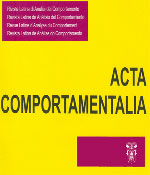Double temporal bisection: Critical tests of two timing models
Main Article Content
Abstract
Throughout six experiments, a double temporal bisection procedure was used to test the predictions of Scalar Expectancy Theory (SET) and the Learning-to-Time (LeT) model. In this procedure, pigeons learn two conditional discriminations. In the first, they learn to choose a Red key after 1-s samples and a Green key after 4-s samples. In the second, they learn to choose a Blue key after 4-s samples and a Yellow key after 16-s samples. Afterwards, the pigeons are tested with intermediate samples as well as with new pairings of key colors. Of fundamental importance is the test with the new pair of keys Green and Blue, both associated with the same sample duration of 4 s. Whereas SET predicts that preference for Green will not vary with sample duration, LeT predicts that preference for Green will increase with sample duration – a context effect. Throughout the experiments, this basic procedure was changed in various ways to test the models’ predictions and to examine the generality of the findings. On most studies, the results were consistent with LeT, but not with SET. The mismatches between the data and SET’s predictions reveal structural inadequacies of the model, in particular its assumption that representations of time intervals are context independent.
Article Details
How to Cite
Machado, A., & Oliveira, L. (2010). Double temporal bisection: Critical tests of two timing models. Acta Comportamentalia, 17(1). Retrieved from https://journals.unam.mx/index.php/acom/article/view/18139
Citas en Dimensions Service

<a rel="license" href="http://creativecommons.org/licenses/by-nc-sa/4.0/"><img alt="Licencia de Creative Commons" style="border-width:0" src="https://i.creativecommons.org/l/by-nc-sa/4.0/88x31.png" /></a><br />Este obra está bajo una <a rel="license" href="http://creativecommons.org/licenses/by-nc-sa/4.0/">licencia de Creative Commons Reconocimiento-NoComercial-CompartirIgual 4.0 Internacional</a>.
